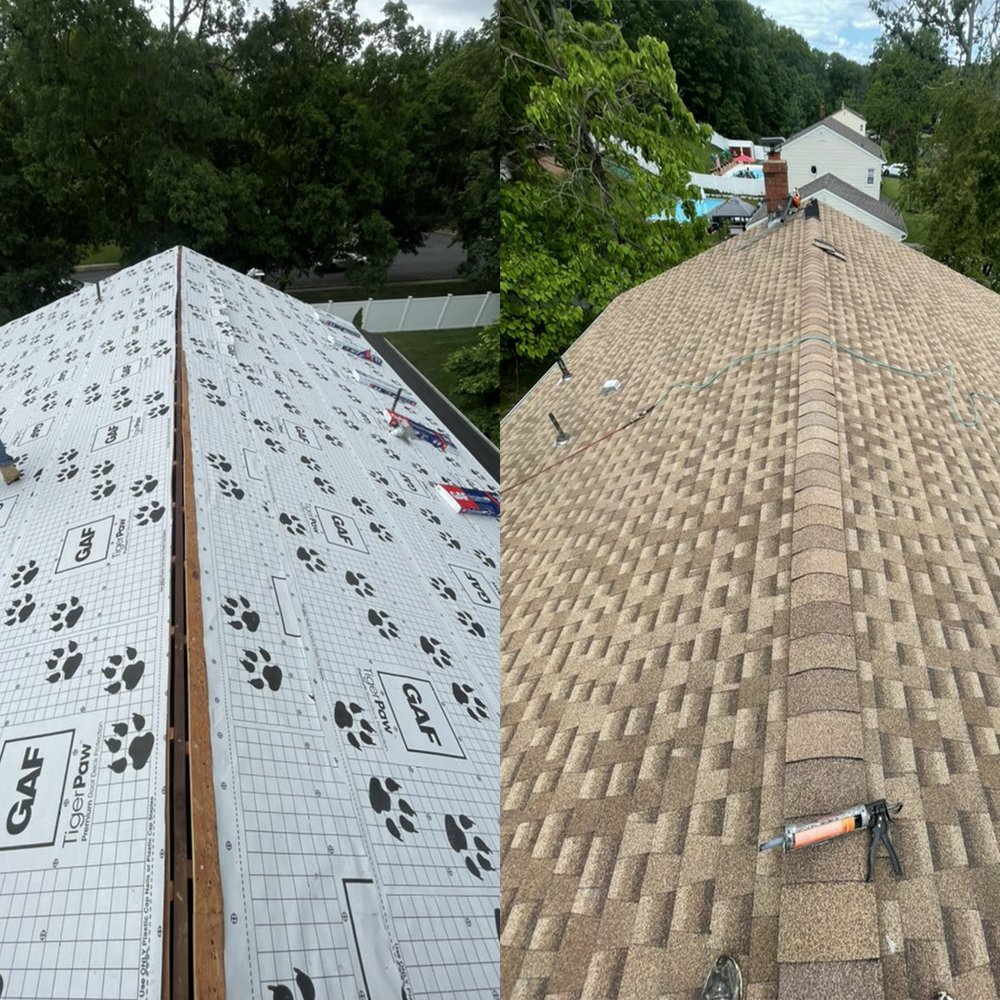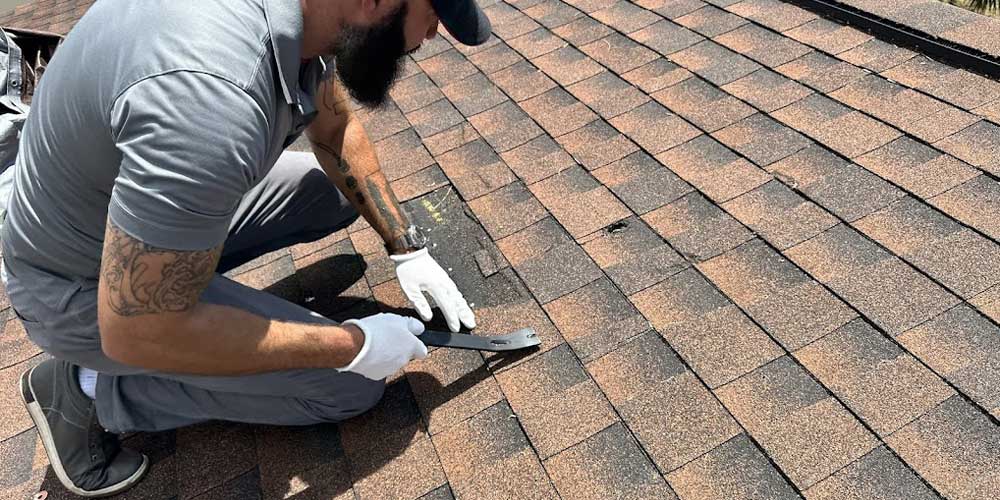A Property owner's Overview to Types of Roofs: Selecting the Right Design for Your Needs

Popular Roofing Styles
When it involves selecting a roof covering design, home owners commonly consider their alternatives thoroughly to ensure both aesthetic appeal and capability. Amongst one of the most prominent styles are the gable, hip, and level roofs, each offering distinctive advantages and visual attributes.
Saddleback roofs, defined by their triangular shape, are preferred for their straightforward style and efficient water drainage. This design is particularly well-suited for regions with heavy rains or snow, as it lessens the danger of water pooling.
Hip roof coverings, which slope on all 4 sides, offer extra stability and durability, making them an outstanding choice for locations vulnerable to high winds. Their architectural complexity permits for higher design versatility and can improve the overall visual appeal of a home.
Flat roofings use a modern aesthetic and maximize usable outdoor area, making them popular for metropolitan settings. While they call for even more upkeep to stop water buildup, their smooth look can match modern architecture.
Inevitably, the selection of roof covering style ought to mirror the house owner's individual taste while taking into consideration elements such as local environment, architectural layout, and possible resale worth. Each style adds distinctly to a home's total personality and efficiency.

Product Options
Selecting the proper roof covering material is just as essential as choosing the best design, as it substantially impacts the roofing system's longevity, maintenance needs, and total visual. roofers oahu. Home owners have a range of alternatives to consider, each with distinct advantages and drawbacks


Steel roof offers outstanding resilience and durability, usually surpassing 50 years, while also being resistant and light-weight to fire and rot. Steel roofings can be much more pricey upfront.
Clay and concrete tiles offer a timeless look and impressive lifespan but call for a durable framework as a result of their weight. These materials are very sturdy and immune to rough climate condition. Wood drinks give a rustic visual however demand normal upkeep to prevent rot and bug damage.
Last but not least, synthetic roof materials, such as rubber or plastic composites, simulate the appearance of conventional products while being low-maintenance and lightweight. Eventually, the choice of roof product ought to align with the property owner's budget, preferred life expectancy, and upkeep choices, ensuring an ideal match for their certain demands.
Power Effectiveness Considerations
Power efficiency plays an essential role in the total efficiency of a roof covering system, influencing both environmental sustainability and property owner energy expenses. When selecting a roofing system, it is necessary to take into consideration materials and designs that enhance power efficiency. As an example, reflective roofing materials, usually referred to as "great roofing systems," can significantly lower warmth absorption, decreasing indoor temperatures and decreasing the requirement for air conditioning.
In addition, the roofing's color and incline can affect its power performance. Lighter colors typically mirror a lot more sunlight, while outstanding pitched roofing systems help with much better air flow, minimizing heat build-up - roofers oahu. Insulation additionally plays an important role; a well-insulated roof can avoid heat loss in winter months and maintain insides cooler in summer, hence improving energy financial savings
In addition, incorporating energy-efficient roof alternatives with photovoltaic panels can better minimize energy costs and dependence on nonrenewable sources. Homeowners need to additionally take into consideration regional environment conditions when selecting roof covering materials and designs, as these aspects directly influence energy usage.
Maintenance Demands
The durability and performance of a roof covering system are significantly affected by the upkeep needs linked with its design and materials. Various roof covering types demand varying degrees of maintenance, which can impact both the property owner's time and spending plan.
Asphalt roof shingles, for example, normally call for yearly assessments to look for damage, including split or missing tiles. Normal cleansing of seamless gutters is vital to stop water damages and lengthen the roof's life-span. Metal roofs, while long lasting, still need routine look for rust and sealer stability. These roof coverings also profit from cleaning to maintain visual allure and capability.
Tile roofings, known for their long life, demand much less regular upkeep yet call for mindful examination and replacement of damaged tiles. Level roof coverings, although supplying modern-day aesthetics, typically require more attention; they need normal inspection for merging water and debris elimination to prevent leakages.
Inevitably, comprehending the maintenance requirements connected with various roofing styles allows home owners to make enlightened decisions, making certain the selected roof straightens with their way of life and commitment to maintenance. Focusing on upkeep will enhance the roof covering's performance and extend its service life, providing comfort for several years to find.
Influence On Resale Worth
When considering a new roof style, homeowners should hop over to here acknowledge that the choice can dramatically influence the property's resale value. A well-chosen roofing not only enhances curb charm yet also signifies to potential purchasers that the home is properly maintained and structurally noise. Various roofing materials and designs carry varying degrees of charm in the property market.
As an example, asphalt shingles are preferred because of their cost and wide variety of shades, frequently attracting budget-conscious customers. Alternatively, a steel roofing system, while more expensive upfront, supplies long life and power performance, which can draw in purchasers looking for low upkeep and sustainability. Furthermore, distinct designs such as slate or tile can include a touch click to read more of deluxe, possibly boosting the residential or commercial property's value in upscale markets.
Regional preferences likewise play a critical role; homes in locations with hefty snowfall might take advantage of considerably pitched roofing systems, while coastal regions might favor durable products resistant to deep sea deterioration (roofers oahu). Inevitably, house owners need to think about both visual appeal and functional benefits when choosing a roofing. A thoughtful choice makes certain that the financial investment not just meets individual requirements however also enhances the property's marketability and resale potential
Final Thought
To conclude, choosing this article the suitable roof style demands a cautious assessment of numerous variables, consisting of regional climate, building style, and maintenance needs. Each roofing option, whether it be gable, hip, or level, possesses distinct benefits and downsides that affect power effectiveness and potential resale worth. Ultimately, a knowledgeable decision relating to roofing system choice can boost the aesthetic appeal, functionality, and durability of a home, ensuring it continues to be a valuable property for years to come.
Choosing the proper roof design for your home is a critical choice that can significantly influence both aesthetics and performance. While gable roofings stand out in water drainage, hip roofs might offer greater strength against wind.When thinking about a new roofing style, homeowners need to acknowledge that the selection can substantially affect the building's resale worth. Ultimately, house owners should take into consideration both visual allure and sensible benefits when picking a roof.In conclusion, selecting the appropriate roofing style necessitates a careful analysis of various variables, including local climate, architectural design, and upkeep demands.